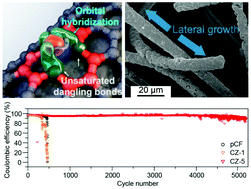Dendrite-free Zn electrodeposition triggered by interatomic orbital hybridization of Zn and single vacancy carbon defects for aqueous Zn-based flow batteries†
Abstract
Aqueous zinc (Zn)-based flow batteries are an attractive option for energy storage systems due to their inflammability and high energy density. However, Zn dendrite formation, which causes internal short circuiting and capacity drop, limits the long-term operation of Zn-based flow batteries. Here, we present highly stable Zn deposition/dissolution achieved by a defective carbon surface. DFT calculations and electrochemical analysis demonstrate that a single vacancy carbon defect prevents the surface diffusion of Zn and consequent aggregative Zn growth by forming a strong orbital hybridization between Zn and the dangling bonds of the defect. Triggered by the interatomic interaction, a defective carbon-decorated electrode achieves dendrite-free Zn deposition and excellent cycling stability in zinc–bromine flow batteries (ZBBs) over 5000 cycles at 100 mA cm−2 and 20 mA h cm−2, while maintaining coulombic efficiency above 97%. The deeper understanding of defect chemistry provides a new scientific strategy to engineer advanced Zn-based aqueous batteries.

- This article is part of the themed collection: Energy & Environmental Science Cover Art


 Please wait while we load your content...
Please wait while we load your content...